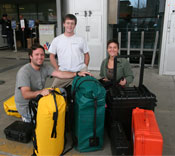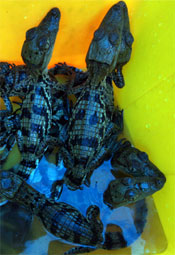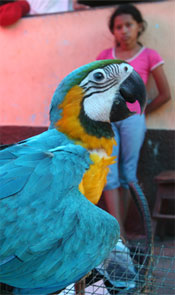Special to mongabay.com: Wilderness Classroom: Expedition 2006 The following is an update from The Wilderness Classroom’s expedition to the Peruvian rainforest. You can follow their adventures at wildernessclassroom.com |
The Adventure Begins–Wilderness Classroom in Peru
The Wilderness Classroom Organization
April 4, 2006
Update 4: It was a long trip, but we made it to Peru – Dave
We boarded a plane in Chicago at 6 pm on Saturday energized and excited about our trip to Peru. When our plane landed in Lima early on Sunday morning, we were very tired and ready for bed. I think traveling 500 miles per hour at 35,000 feet that makes it hard for me to sleep on airplanes. I think Anna and Patrick were having the same problem.
Luckily Ruben, our team member from Lima, met us at the airport and took us to a hotel near his house. Ruben has a car and a motorcycle, which he uses get around Lima. However, we could not fit all of our gear into his car, so we all took a taxi from the airport to our hotel. Taxis are a common form of transportation in Lima and other large cities in Peru. A 30 minute taxi ride from the airport to our hotel cost us 30 soles. Can you figure out how much we spent in US dollars for our taxi ride? Each US dollar is worth 3.336 Peruvian soles.
The sun was just rising as we sped through Lima. Streets normally clogged with cars, buses, bikes, and motorcycles were empty. I have never screen the streets of Lima look so quiet. Soon we will be exploring the rainforest in canoes. For now, we will stick to using gas-powered vehicles and our trusty feet as we explore Lima and purchase maps, medicine, and other supplies. Soon we will board one last airplane, fly up and over the Andes Mountains, and down into the Amazon Basin. I can’t wait to get to Iquitos to start exploring the rainforest!
Update 4: The Domesticated Wolves of Lima – Patrick
Since we are still far from the Amazon, the chance of seeing a howler monkey or caiman is very slim. Here in Lima, Peru, a giant city of over 10 million people, we have come across a “wild” animal of a different sort.; the domesticated dog. Lurking around the streets and alleys, stray dogs can be seen everywhere. As they are “wild,” there are several things we should know about stray dogs before sharing the streets.
Did you know that Dogs are domesticated Wolves? How could that be? Does that mean your dog is basically a wolf?
About 15,000 years ago, humans started to build cities. Some hungry wolves found easy meals provided by the man-made trash piles in the village. Soon people began to intentionally feed the wolves and the bond began; this was the beginning of domestication of the dog. The main behavior defining dogs from wolves was this willingness to eat near humans.
 Dave, Patrick, and Anna huddle around their mound of gear before entering the Airport in Chicago on Saturday night. |
A wolf’s life changes drastically as soon as it finds a reliable, sizeable meal without hunting. Their world shrinks along with their need for speed and predatory skills. In fact, dogs have a smaller brain and less powerful bodies than wolves. This is clear by the looks of the many mangy mutts strolling through Lima. The odd thing is that no one takes ownership of the dogs and there are no government agencies working to control the dog population.
Certainly I can try to understand the situation better. Perhaps the dogs are helpful cleaners of the streets, eating all the smelly, decomposing food. Maybe they serve as a protection or security alarm to warn of intruders. Maybe they possess some mystical powers that people are attracted to. Whatever the story is, we will be sure to keep our distance from stray dogs. Just as if they were wild animals, we will not feed the dogs.
Update 4: Our first contact with Peruvians – Anna
Our first interaction with a person from Peru happened as we were settling into our flight from Miami to Lima. I asked the man next to me if he was going home and he said, “Yes.” It had been two months since he had been home. He works part of the year in Miami on cruise ships and flies home in between the cruises to see his family. The man I met is from Iquitos. Iquitos is the city in the rainforest where we will be purchasing our supplies for the trip. I got excited so I showed the man a video of the anaconda that we found last year. He wasn’t impressed. He told me that he sees anacondas all the time and they are much bigger than the one in the photo. I hope that he was just trying to impress me!
Ruben picked us up from the airport after our flight from Peru. When we walked outside of the airport, we were immediately swarmed by taxi drivers that very much wanted to take us to our destination. Driving taxis is a common way for people to make a living in Lima, since most people don’t own cars and Peru is popular with tourists. Finally, one taxi driver won our vote, and he loaded up our things and off we went.
On the ride to our hotel, I noticed that most cars don’t follow the traffic signals. Red lights were run and stop signs were ignored. Honking happens everywhere and at everything, especially passing by a side street where a car might be pulling out. Our taxi driver honked at the cars he was passing, honked at the stop signs, and even honked at the dogs eating trash on the side of the road.
We passed many street vendors getting ready to set up their mini markets for the day. Many of them ride a bike with their little booth on wheels attached to the back. They actually ride on the same road as the cars, and they take up most of the right lane. As cars and taxi cabs fly by on the left, the bicycling street vendors are nearly run off the road. Maybe they are used to it, but I sure wasn’t!
Before arriving at the hotel, our taxi driver stopped to get gas. I was surprised to see that gas is about four dollars per gallon in Lima. That is extremely expensive especially since people make very little money here. How does this compare to the cost of gasoline in the United States? Do you think it’s higher or lower?
Thanks for joining us on our first day in Peru. See you in Iquitos!
Update 4: Daily Dilemma – Dave
We are planning our time in Iquitos carefully because we have a lot of supplies to buy before heading into the wilderness. There are several ways to get around the city of Iquitos. We need you to help us decide which way would be the best. Iquitos is the largest river port in Peru. This means that boats carrying cargo are constantly going in and out of the city. The place where we will be shopping for supplies, the Belen market, is a floating shantytown of huts built on rafts, which rise and fall with the river. Canoes are commonly used to float from hut to hut, buying, selling, and trading jungle produce. We can pay someone a small fee to have them show us around. It would also be helpful to have the canoe carry our heavy gear. Taxi cabs can be used to travel across the city but traffic can be very slow. Another way to get around is the mottocarro, a modified motorcycle with a bench to carry three passengers. Mottocarros get around easier, and cost less than a taxi, but they are dangerous since they provide very little protection in an accident. Finally, there is always your own two legs. Walking is a reliable, safe, and cost free way to get around. Which way do you think would be the best and most efficient way of shopping for supplies: taxi, canoe, mottocarro, or feet?
Plants, Animals, or People: What should we study first?
Next week we will be entering the rainforest. Our focus for this trip is to study how plants, animals, and people survive in the flooded forest.
What should we study first? After we ride the riverboat from Iquitos, we have the option to immediately enter the forest to begin studying the plants and animals, or to visit with one of the local villages where we begin our trip. Should we focus the beginning of our trip on the people, plants, or animals of the flooded forest? We could focus on people by spending extra time in a community on the edge of Pacaya Samiria National Reserve. We could also focus on the plants by learning about plants in the rainforest that can be used as medicine. Finally, we could spend our first week in the flooded forest focusing on the animals, by traveling deep into the forest as we try to see as many animals as we can.
I was overwhelmed by the whirling colors, over-powering smells, and wild sounds as we wound our way through a maze of vendors. Our team had come to the Belen Market in Iquitos to purchase supplies for our journey into the flooded forest, and also to get a glimpse of life on the Amazon River.
 Baby caimans that he found in the Belen Market. |
The Amazon River is the life-blood of the South American rainforest. The people of Iquitos depend on the river for many things. Here in the Belen Market, the important role the river plays in people’s lives is easy to see.
Every day thousands of people arrive in the Belen Market to sell everything from medicinal plants and pickled snakes to bananas and rice. An old man slowly paddles by in a dugout canoe filled with fish he has caught in the river and transported to the market by canoe. Rivers are the roads of the Amazon, and the closer we walked to the water’s edge, the busier and more crowded the market became.
The market is broken into sections. For example, there is a section filled with people selling medicinal plants and traditional remedies gathered from the surrounding rainforest. Another section was full of people selling meat, another for fruits and vegetables. Other parts of the market are reserved for clothing, fishing supplies, machetes, farm equipment. The list goes on and on, just like the market.
Some parts of the market are very interesting, like the medicinal plants. Other parts are hard to take. The smell of the stalls selling meat was pretty hard to stomach. Remember, there is no refrigeration in the market, so all of the meat is slowly cooking in the 90 degree heat. As the day goes on, the smells of the market intensify.
I love all of the new sights and sounds that the river has brought to the market, but I am ready to travel up river to see what we will find around the next bend.
Update 5: The Seeds Have Wings – Patrick
One of the fascinating traits of the Amazon is the way the plants use the animals, just as the animals use the plants. The chocolate tree, or cacao tree, grows in the rainforest. It grows huge pods the size of footballs that are filled with 10-30 seeds. The seeds, which are the cocoa in your candy bar, are covered in a sweet, fruity pulp. The pulp is created to attract animals that will eat the pulp, swallow the seed, and then distribute the seeds to other areas of the rainforest. The seed distribution actually happens when the seeds go through the animal’s digestive system. This is one of the ways that the cacao tree survives in the flooded forest. Animals like howler monkeys, capybara, and sloths, are not only getting a tasty treat when they eat the pulp covered seeds, they are helping the tree reproduce.
 A blue and gold macaw with its wings clipped hangs out waiting to be sold. The abundance of fruit in the market keeps this bird well fed. |
Another animal that distributes seeds is the toucan, a large, beautifully-colored bird. The toucan loves to eat rainforest fruits. These large-beaked birds swallow the fruits whole. The pulp is digested, and the seeds are spit out the way they came in. When the toucan regurgitates (vomits) its food, the seeds are planted on the rainforest floor. This is a way that toucans help the different fruit trees of the Amazon reproduce and travel. What unbelievable relationships and behaviors are shared in the rainforest!
Can you think of other ways the plants disperse their seeds?
Update 5: Motorcycling South America – Anna
Ruben and his friend, Geraldine, just completed an 8,000 mile trip throughout South America on Ruben’s 250cc motorcycle! That is like driving an entire loop around all of North America. With Geraldine hanging on tight behind Ruben, the two traveled through Peru, Brazil, Chile, and Argentina. There are not many highways in South America. This means that the pair spent a lot of time zipping along two lane roads as they toured. Ruben says they rode the motorcycle nearly every day for one month from sunrise until sunset. One time, they were about to drive on a 400 mile stretch of road where there would be no gas station the entire time. The tank of his motorcycle only holds enough gas for 250 miles. What did they do? Ruben and Geraldine simply filled up several gas cans and Geraldine held them on the back of the little motorcycle as they continued their journey. That is one tough woman!
Motorcycles and mopeds are a common means of transportation in South America. In Iquitos, the city that we are in right now, nearly everyone on the roads drives a motorcycle. Even the taxis are three wheeled motorcycles; the customers sit on benches behind the driver. One of the reasons people drive motorcycles is because they are inexpensive to buy and they don’t use a lot of gas. Can you think of other reasons why motorcycles are so popular in South America?
May the forest be with you,
Update 5: A Monkey on a Chain – Dave
The Belen market in Iquitos is one of the most fantastic shopping experiences in the world. People bring goods from the all over the vast Amazon basin to Iquitos, which is known as the capital of Peru’s rainforest. As you may be able to imagine, the market’s shops sell just about anything we have ever dreamt of
and some things we never knew existed! From fish and vegetables to herbal medicines and tribal artifacts, the market abounds with the fruits of the region. We have also found several animals that have been taken from their homes in the rainforest. Macaws are stuck in cages, snakes in burlap sacks, monkeys leashed, and a sloth hanging out on men’s shoulders. These animals are being displayed and sold as pets.
We are not sure what to think of the animal trade. It seems like the animals in human captivity are not living as they are supposed to.
We will be spending lots of time and money at the Belen market to get all of our food, so we were wondering if you could help us to better understand the situation. Do you think that animals should be taken from the rainforest and sold as pets? Explain your answer, and if you think selling pets in the market is a bad idea let us know how we can help.
Live Chat Today! The Expedition Team will be in the Chat Room on Wednesday, April 5 from 10:00 – 11:00 AM CST.
Track the adventurers at wildernessclassroom.com